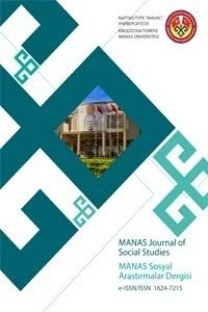KONAKLAMA SEKTÖRÜNDE DUYUSAL MARKALAMANIN ÖNEMİ: BEŞ YILDIZLI BİR OTEL ÖRNEĞİ
THE IMPORTANCE OF SENSORY BRANDING IN ACCOMMODATION SECTOR: A FIVE STAR HOTEL CASE
___
- Agapito, D., Valle, P. O., Mendes, J. (2012). Sensory Marketing and Tourist Experiences. Spatial and Organizational Dynamics Discussions Papers. 10, 7-19.
- Aksoy, Y. Ö. (2017). Duygusal Marka Deneyimi, Marka Ayırt Ediciliği, Marka Çekiciliği ve Marka Savunuculuğu Arasındaki İlişkiler. İşletme Araştırmaları Dergisi. 9(3), 360 – 374.
- Alemdar, M. Y. (2012). Duygusal Pazarlamada Değer Yıldızı Modeli Beyaz Eşya Tv Reklam Mesajları Üzerine Bir İnceleme. Global Media Journal:Turkish Edition. 3(5), 208 – 245.
- Aslan, H., Topaloğlu, C., Kılıç, B., Yozukmaz, N. (2017) Yiyecek ve İçecek İşletmelerinde Duyusal Pazarlama Uygulamaları. Journal of Tourism and Gastronomy Studies. 5(2), 287-300.
- Atay, L., Çeti, B. (2018). Temalı Otellerde Konaklayan Turistlerin Deneyimlerinin Belirlenmesi: Botel Örneği. Manas Sosyal Araştırmalar Dergisi. 7(1), 555-572.
- Batı, U. (2017). Markethink ya da Farkethink. İstanbul: Kitap Kulübü Kitapları.
- Çakır, S. Y. (2010). Markaların Duyular Yoluyla Şekillenmesi: Duyusal Markalama. Erciyes İletişim Dergisi. 1(4), 39 – 62.
- Ditoiu, M. C., Stancioiu, A. F., Bratucu, G., Onişor, L. F., Botoș, A. (2014). The Sensory Brand Of The Destination. Case Study: Transylvania. Theoretical and Applied Economics. 21(5), 37-50.
- Erciş, A., Çelebi, Y. (2016). Marka Konumlandırma Ve Tüketicilerin Marka Kişiliği Algılamaları (Erzurum'da Beyaz Eşya Sektörü Üzerine Bir Araştırma). Journal of International Social Research. 9(45), 753 – 767.
- Gülmez, E. (2017). Marka Tercihinde Duyuların Rolü: Starbucks ve Kahve Dünyası Markalarının Duyusal Markalama Açısından Karşılaştırılması. Gümüşhane Üniversitesi Sosyal Bilimler Enstitüsü Eloktronik Dergisi. 5(1), 58 – 84.
- Goldkuhl, L., Styvén, M., (2007). Sensing The Scent Of Service Success. European Journal of Marketing. 41(11/12), 1297-1305.
- Homburg, C., Koschate, N., Hoyer, W.D. (2005), The İnterplay Of Cognition And Affect İn The Formation Of Customer Satisfaction: A Dynamic Perspective. American Marketing Association Conference Proceedings. San Antonio, Vol. 16.
- http://www.samresearch.com/research-services/services-approaches/qualitative-approaches/ E.T: 14.01.2018
- Hulten, B., Broweus, N., Dijk, M. (2009). Sensory Marketing. London: Palgrave Macmillan
- Hulten, B. (2012). Sensory Cues and Shoppers’ Touching Behaviour: The Case of IKEA. International Journal of Retail & Distribution Management. 40(4), 273-289.
- Isacsson, A., Alokoski, L., Back, A. (2009). Using Multiple Senses İn Tourism Marketing: The Helsinki Expert, Eckero Line And Linnanmaki Amusement Park Cases. 2009. 167–184.
- Koç, E. (2012). Tüketici Davranışı ve Pazarlama Stratejileri. Ankara: Seçkin Yayıncılık
- Krishna, A., Schwarz, N. (2014). Sensory Marketing, Embodiment, And Grounded Cognition: A Review And İntroduction. Journal of Consumer Psychology. 24(2), 159-168.
- Krishna, A. (2012). An İntegrative Review Of Sensory Marketing: Engaging The Senses To Affect Perception, Judgment And Behavior. Journal of Consumer Psychology. 22(3), 332-351.
- Krishna, A. (2011). Sensory Marketing: Research On The Sensuality Of Products. London: Routledge.
- Lindstrom, M. (2005). Brand Sense. New York: Free Press
- Morgan, M., Elbe, J., Esteban C. J. (2009). Has The Experience Economy Arrived Yet? The Views Of Destination Managers. International Journal of Tourism Research. 11(2), 201-216.
- Mossberg, L. (2007). A Marketing Approach to the Tourist Experience. Scandinavian Journal of Hospitality and Tourism. 7(1). 59-74.
- Pine, B. J., Gilmore, J. H. (1998). Welcome to the Experience Economy. Harvard Business Review. 76, 97-105.
- Roberts, K. (2007). Lovemarks: Markaların Ötesindeki Gelecek. (Çev: İnci Berna Kalınyazgan). İstanbul: MediaCat Kitapları
- Rushton, A.M., Carson, D.J., (1989). The Marketing Of Services: Managing The İntangibles. European Journal of Marketing. 23(8), 23-44.
- Schmitt, B. (1999). Experiential Marketing. Journal of Marketing Management. 15(1-3), 53-67.
- Skandranı, H., Ben Dahmane Mouelhı, N., Malek, F. (2011). Effect Of Store Atmospherics On Employees' Reactions. International Journal of Retail & Distribution Management. 39.(1), 51-67.
- Tosun, N. B., Elmasoğlu, K. (2015). Duyusal Markalamanın Marka Sadakati Üzerindeki Rolü. Maltepe Üniversitesi İletişim Fakültesi Dergisi. 2.(1), 91-111.
- Tan, C. S. (2008). Men, Beauty And Senses–A Snapshot Of The Effectıveness Of Sensory Branding In The Japanese Men’s Cosmetıcs Market. Journal of Yaşar University. 3.(9), 1047–1060.
- Uztuğ, F. (2002). Markan Kadar Konuş. İstanbul: MediaCat Kitapları.
- Xu, J.B., Chan, A., (2010). A Conceptual Framework Of Hotel Experience And Customerbased Brand Equity. International Journal of Contemporary Hospitality Managemen. 22(2), 174-193.
- Yozukmaz, N., Topaloğlu, C. (2016). Senses in Hospitality: How Do Hotels Appeal to Them?. Journal of Tourism and Hospitality Management. 4(2), 51-74.
- ISSN: 1694-7215
- Yayın Aralığı: 4
- Başlangıç: 2001
- Yayıncı: KIRGIZİSTAN-TÜRKİYE MANAS ÜNİVERSİTESİ
ÜNLÜ KIRGIZ ELEŞTİRMEN SALİCAN CİGİTOV'UN İLMÎ KİŞİLİĞİ VE MAKALELERİNE BİR BAKIŞ
PEYZAJ TASARIMINDA ETİK VE SORUMLULUK
Serhat YÜKSEL, Hasan DİNÇER, Şenol EMİR
ÜNLÜ KIRGIZ ELEŞTİRMEN SALİCAN CİGİTOV'UN İLMÎ KİŞİLİĞİ VE MAKALELERİNE BİR BAKIŞ
İSLAM HUKUKUNDA ŞÂYİ MALIN KİRALANMASI
ESRA GÜLENGÜL, Mâzin Misbah SABBÂH
LİSE SON SINIF ÖĞRENCİLERİNİN GÖZÜ İLE EĞİTİME VE YÜKSEKÖĞRETİME BİR BAKIŞ
MEHMET KOÇYİĞİT, ERAY EĞMİR, Mustafa AKÇİL
BAZI AVRUPALI RESSAMLARIN “KANA’DA DÜĞÜN” KONULU ESERLERİ ÜZERİNE
VASFİYE ÇELİK, ŞERİFE PEKKÜÇÜKŞEN
TEDARİKÇİ İLİŞKİLERİNİN İNOVASYONA ETKİSİ: GAZİANTEP ORGANİZE SANAYİ BÖLGESİ’NDE BİR ARAŞTIRMA
